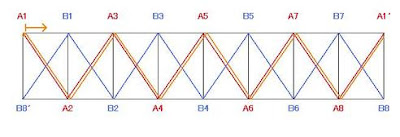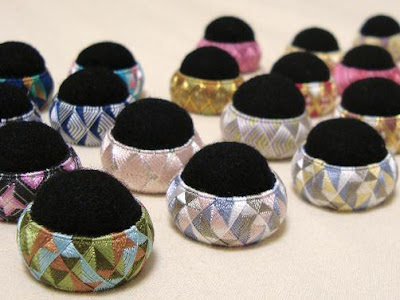As promised a long long time ago, here is a tutorial of making bi-coloured scales design thimble. Before I proceed, I would like to thank Neabear, coral-seas, SunshineCraft, Debi, and Mary Corbet for responding my enquiry earlier regarding segments and sections. I also consulted with other sources and they all agreed that there is no big difference either I call them segments or sections. Considering that I have already used the word segments in the previous posts and I do not wish to change all the words, I will stick to "segments" for the time being until I may decide otherwise in the future.
Now, since this bi-coloured design is what most of the people makes firstly before trying other designs, it is considered the easiest to make (or perhaps it's the other way around, it's easiest and people makes them first) however, it's quite a tough design to make. First of all, as you use only two colour without fancy design, it clearly shows your skill. Secondly segments are relatively wide so your padding may be caught with your stitching threads. Still it involves only two threads with no changing colour in one segment, I chose this one for my first design tutorial.
As I told you before scales design is collective triangles in Japanese culture, signifying serpents or dragons scales. Dragons in Eastern Asian culture, contrary to the Western world, are nature's spirit or gods wielding a great power over the weather and water such as ocean and river. You see, dragons don't breath fire in Eastern Asia. I will not going further here but you can find books about Eastern dragons in the anthropology section at your local library. Back to the thimbles. This design is simple yet elegant, suitable to your very first thimble.
Here is a diagram. Rectangles with crossings in red and blue with numbers and arrows. But this tells you how to make your thimble.
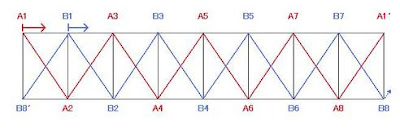 I would like you to consider diagrams are instructions on your marking papers. Those eight rectangles are segments as you see below and I numbered with A's and B's alternatively both at top and bottom. As your marking paper is wrapped around the thimble base, A1 and A1', and B8 and B8' are the same point.
I would like you to consider diagrams are instructions on your marking papers. Those eight rectangles are segments as you see below and I numbered with A's and B's alternatively both at top and bottom. As your marking paper is wrapped around the thimble base, A1 and A1', and B8 and B8' are the same point.  Then the arrow beneath A1 is to signify your first starting point is A1 and the direction you take is right, means regular forward stitching. You are going to make your initial stitch at A1 and then forward to A2 then A3, zig-zaging until you would get to A1' which is same as A1 where you make your first stitch of the second row right next to the initial stitch.
Then the arrow beneath A1 is to signify your first starting point is A1 and the direction you take is right, means regular forward stitching. You are going to make your initial stitch at A1 and then forward to A2 then A3, zig-zaging until you would get to A1' which is same as A1 where you make your first stitch of the second row right next to the initial stitch.
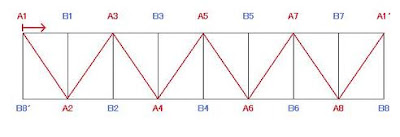 Then you thread another colour and starting from B1 to B8', then B1 again with the first stitch of the second row as the below diagram show you. After both of your first rows are done with first stitches of the second rows, you get back to the colour A and start the second row, ending the row with the first stitch of the third row.
Then you thread another colour and starting from B1 to B8', then B1 again with the first stitch of the second row as the below diagram show you. After both of your first rows are done with first stitches of the second rows, you get back to the colour A and start the second row, ending the row with the first stitch of the third row. In order to make it clear I change the colour of the second row of colour A. For some unknown reasons I cannot upload any picture file bigger than 500 pixels wide, so it does not clearly appear as I wished.
In order to make it clear I change the colour of the second row of colour A. For some unknown reasons I cannot upload any picture file bigger than 500 pixels wide, so it does not clearly appear as I wished.
Once you finished your second row of the colour A, it should be like below,
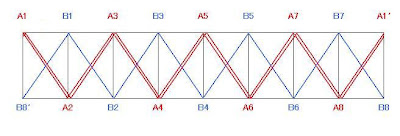 Then thread the colour B, and make stitches all around.
Then thread the colour B, and make stitches all around.
 Continue stitching colour A and colour B alternatively until all the segments are filled with stitches, thus the body of the thimble is covered, too.
Continue stitching colour A and colour B alternatively until all the segments are filled with stitches, thus the body of the thimble is covered, too. 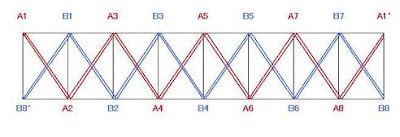
When using a lip balm casing for a mold as I do, I recommend to have 8 or 10 segments. Any more, the finished triangles are too steep and do not look like scales (as Japanese people consider the way they should be) and any less, you might have a problem covering edges and body at the same time. It may not make sense to you right now, but take my word for it, you do not want to have this particular problem now. Be aware that your segments are always in even numbers for this design. You cannot make scales with odd numbered segments while some designs, like blue waves, can be made with both odd and even numbered segments.
Let me know when I didn't make it very clear and I will try to explain more clearly. Those of you who are wondering how to make stitches and thimble bases, you pop in here for making bases, here and here for stitching, and here for suggestions of silk alternatives.
Happy stitching!

